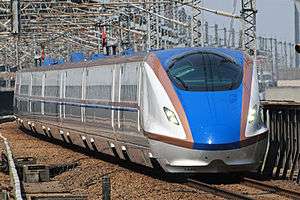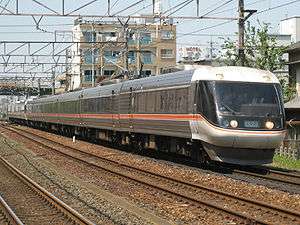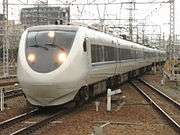700 Series Shinkansen
| 700 series | |
|---|---|
 A 700 series train on the Tokaido Shinkansen between Kakegawa and Shizuoka in January 2008 | |
| In service | 1999–Present |
| Manufacturer | Hitachi, Kawasaki Heavy Industries, Kinki Sharyo, Nippon Sharyo |
| Replaced | 0 series, 100 series, 300 series |
| Constructed | 1997–2006 |
| Scrapped | 2012– |
| Number built | 1,328 vehicles (91 sets) |
| Number in service | 912 vehicles (65 sets) (As of 1 April 2016)[1] |
| Number preserved | 1 vehicle |
| Number scrapped | 415 vehicles (26 sets) |
| Formation | 8/16 cars per trainset |
| Capacity |
16-car sets: 1,323 (200 Green + 1,123 Standard) 8-car sets: 571 |
| Operator(s) |
|
| Depot(s) | Tokyo, Osaka, Hakata |
| Line(s) served |
Tokaido Shinkansen Sanyo Shinkansen Hakata-Minami Line |
| Specifications | |
| Car body construction | Aluminium |
| Car length |
25,000 mm (82 ft 0 in) (intermediate cars), 27,350 mm (89 ft 9 in) (end cars) |
| Width | 3,380 mm (11 ft 1 in) |
| Height | 3,690 mm (12 ft 1 in) (without rooftop equipment) |
| Doors | 2 per side |
| Maximum speed | 270 km/h (170 mph) (Tokaido), 285 km/h (177 mph) (Sanyo) |
| Traction system |
48 x 275 kW (369 hp) (16-car set), 24 x 275 kW (369 hp) (8-car set) |
| Power output |
13.2 MW (17,700 hp) (16-car set), 6.6 MW (8,900 hp) (8-car set) |
| Acceleration | 2.0 km/h/s (0.56 m·s−2) |
| Deceleration | 2.7 km/h/s (0.75 m·s−2) |
| Electric system(s) | 25 kV AC, 60 Hz overhead catenary |
| Current collection method | Pantograph |
| Safety system(s) | ATC-1, ATC-NS |
| Track gauge | 1,435 mm (4 ft 8 1⁄2 in) |
The 700 series (700系 Nanahyaku-kei) is a Japanese Shinkansen high-speed train type built between 1997 and 2006, and entering service in 1999. Originally designated as "N300" during the development phase, they formed the next generation of shinkansen vehicles jointly designed by JR Central and JR-West for use on both Tokaido and Sanyo Shinkansen lines.
Design
The 700 series is characterized by its flat 'duck-bill' nose designed to reduce the piston effect as the trains enter tunnels. 16-car units are painted white with blue stripes beneath the windows, and are used for Nozomi, Hikari, and Kodama services on the Tokaido and San'yō Shinkansen lines, while 8-car units used for the San'yō Shinkansen Hikari Rail Star services have a darker livery (grey with black window areas and a yellow stripe beneath the windows) which also acts to visually deemphasize the units' nose area, resulting in a more streamlined impression.
As with the 500 series trains, yaw dampers are fitted between vehicles, and all cars feature semi-active suspension to ensure smooth ride characteristics at high speed. Compared with the small fleet of high-performance, high-cost 500 series trains built for JR-West, these trains were designed to give improved ride comfort and interior ambience over the earlier 300 series trains at a lower cost than the 500 series trains. The cost of a 16-car 700 series unit is approximately 4 billion yen compared with around 5 billion yen for a 16-car 500 series train.
Operations
700 series trainsets are scheduled to be withdrawn from Tokaido Shinkansen services by the end of fiscal 2019.[2]
Variants
- 700-9000 series: 16-car pre-series set
- 700-0 series: 16-car "C" sets owned by JR Central, introduced from March 1999
- 700-3000 series: 16-car "B" sets owned by JR-West, introduced from 2001
- 700-7000 series: 8-car Hikari Rail Star "E" sets owned by JR-West, introduced from 11 March 2000
Pre-series unit (700-9000 series)
The pre-series set, C0, was delivered in October 1997, and underwent endurance running mainly between Tokyo and Shin-Osaka until early 1999, including a short period of testing as an 8-car formation on the Sanyo Shinkansen. New single-arm current collectors were fitted from the start, and these initially featured the distinctive "wine-glass" pantograph shrouds of the 300X train. These were later changed to a design resembling the 500 series arrangement with additional side fences, which was used on the subsequent production trains. Unit C0 was modified to full production standard in September 1999 and renumbered as C1.
 Set C1 in service in January 2010
Set C1 in service in January 2010
16-car C sets
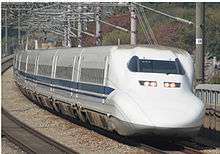
These units were ordered by JR Central for use on Tokyo to Hakata Nozomi services, displacing the 300 series trains previously used on these services. Interior layout and accommodation is similar to that of the 300 series trains, with three Green class (first class) vehicles, and the same 1,040 mm seat pitch in standard class, and 1,160 mm in Green class. The central gangways were widened by 30 mm to 600 mm, and ceilings were raised by 65 mm to 2,200 mm. The refreshment counters of the 300 and 500 series trains were discontinued and replaced by vending machines selling drinks, located in cars 3, 7, 11, and 15.
Specifications permit 285 km/h running on the Sanyo Shinkansen with speed restricted to 270 km/h on the Tokaido Shinkansen between Tokyo and Shin-Osaka. The initial batch ordered by JR Central consisted of 17 units, with the first 4 units delivered in time for introduction on three daily return Nozomi services from March 1999. Services featuring 700 series stock were increased to five daily from July 1999, and further increased from October 1999. With continuing deliveries, 700 series trains were also introduced on Tōkaidō Shinkansen Hikari services from late 2000.
Set numbers C25 onwards introduced from May 2001 incorporate minor interior design improvements, including power outlets at the ends of cars for PC users, and hand-grabs on the edge of aisle seats. An order for an additional batch of six units was placed by JR Central in December 2003, with delivery scheduled for the end of 2004. These sets (C55 to C60) provided additional capacity for services connected with the Aichi Expo in 2005.
Before entering passenger service, JR Central set C46 was used on a series of test runs from late January 2003 fitted with streamlined bogie covers on all cars and flush diaphragm covers between cars 16/15 and 15/14. These modifications were removed before the unit entered revenue service. Flush diaphragm covers were used on future trains, such as the N700 series.
Between October 2008 and June 2009, JR Central's fleet of 60 700 series sets underwent modifications to increase the acceleration from the original 1.6 km/h/s to 2.0 km/h/s (0.44 m·s−2 to 0.56 m·s−2) on the Tokaido Shinkansen to improve timetable planning flexibility.[3]
During fiscal 2011, eight JR Central "C" sets (C11 to C18) were transferred to JR-West to replace its fleet of nine 300 series sets scheduled to be withdrawn by spring 2012.[4]
Withdrawals of 700 series sets began in 2012 with the withdrawal of set C4. It continued in 2013 (sets C1, C2, C3, C5 - C8) and in 2014 (C9, C10, C20 - C24).
Formation
The 16-car C sets are formed as follows, with car 1 at the Hakata (west) end.[5]
| Car No. | 1 | 2 | 3 | 4 | 5 | 6 | 7 | 8 | 9 | 10 | 11 | 12 | 13 | 14 | 15 | 16 |
|---|---|---|---|---|---|---|---|---|---|---|---|---|---|---|---|---|
| Designation | Tc | M2 | M'w | M1 | M1w | M' | M2k | T's | Ts | M2s | M'h | M1 | M1w | M' | M2w | T'c |
| Numbering | 723 | 727 | 726-500 | 725 | 725-300 | 726 | 727-400 | 718 | 719 | 717 | 726-700 | 725-600 | 725-500 | 726-200 | 727-500 | 724 |
| Seating capacity | 65 | 100 | 85 | 100 | 90 | 100 | 75 | 68 | 64 | 68 | 63 | 100 | 90 | 100 | 80 | 75 |
Cars 5 and 12 each have one single-arm pantograph.
Interior
 Green-class car (car 9) in March 2010
Green-class car (car 9) in March 2010 Standard-class car (car 13) in January 2010
Standard-class car (car 13) in January 2010
16-car B sets (700-3000 series)
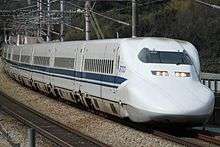
These are the units owned by JR-West for use on through Hikari services from Tokyo, displacing the 100 series stock previously used on these services. A total of 15 units were delivered from June 2001 to 2005. These trains use the same bogies as the JR-West 500 series sets. Other differences include LED destination indicator panels, white pantograph side fences, "JR 700" logos on the cab sides, and also different seat designs.
Formation
The 16-car B sets are formed as follows, with car 1 at the Hakata (west) end.[5]
| Car No. | 1 | 2 | 3 | 4 | 5 | 6 | 7 | 8 | 9 | 10 | 11 | 12 | 13 | 14 | 15 | 16 |
|---|---|---|---|---|---|---|---|---|---|---|---|---|---|---|---|---|
| Designation | Tc | M2 | M'w | M1 | M1w | M' | M2k | T's | Ts | M2s | M'h | M1 | M1w | M' | M2w | T'c |
| Numbering | 723-3000 | 727-3000 | 726-3500 | 725-3000 | 725-3300 | 726-3000 | 727-3400 | 718-3000 | 719-3000 | 717-3000 | 726-3700 | 725-3600 | 725-3500 | 726-3200 | 727-3500 | 724-3000 |
| Seating capacity | 65 | 100 | 85 | 100 | 90 | 100 | 75 | 68 | 64 | 68 | 63 | 100 | 90 | 100 | 80 | 75 |
Cars 5 and 12 each have one single-arm pantograph.
Interior
- JR-West standard class seating
- JR-West Green class seating
8-car E sets (700-7000 series)
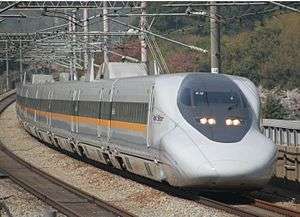

8-car E units were introduced by JR-West for use on new limited-stop Sanyo Shinkansen Hikari Rail Star services between Shin-Osaka and Hakata from 11 March 2000, replacing the former 0 series West Hikari services. The first units were delivered at the beginning of December 1999, with a total of 16 units built. Externally, these units differ noticeably from their JR Central sisters in having a variation of the 500 series livery with the blue waistline band replaced by a band of "sunny yellow". "Rail Star" logos are applied to the sides of alternate cars as well as on the cab sides. Each 8-car train has two single-arm pantographs of a similar design to the JR Central 16-car sets. It was originally planned that sets would be able to operate coupled together, enabling 16-car formations to be run in busy periods, but this feature has never been utilized. With the discontinuation of Hikari services between Shin-Osaka and Hakata, replaced by Sakura services from 2011, these sets are primarily used on Kodama services between Shin-Osaka and Hakata.[6]
Formation
The 8-car E sets are formed as follows, with car 1 at the Hakata (west) end).[5]
| Car No. | 1 | 2 | 3 | 4 | 5 | 6 | 7 | 8 |
|---|---|---|---|---|---|---|---|---|
| Designation | Tc | M1 | Mpk | M2 | M2w | Mp | M1kh | T'c |
| Numbering | 723-7000 | 725-7600 | 726-7500 | 727-7000 | 727-7100 | 726-7000 | 725-7700 | 724-7500 |
| Seating capacity | 65 | 100 | 80 | 80 | 72 | 72 | 50 | 52 |
Cars 2 and 7 each have one single-arm pantograph.
Interior
The trains feature four 4-seat compartments in car 8, and the seats at the ends of each car have power supply outlets for mobile PC users. Unlike the 0 series SK sets which they replaced, no Green class accommodation is provided. However, the five reserved standard class cars, cars 4 to 8, have club class style 2+2 abreast seating compared to the normal 2+3 seating arrangement in the non-reserved cars. Seat pitch is 1,040 mm (41 in) throughout. Car 4 was also designated as a "Silence car", in which onboard announcements were omitted, but this was discontinued from March 2011.[6]
.jpg) Hikari Rail Star non-reserved car 3+2 seating in November 2009
Hikari Rail Star non-reserved car 3+2 seating in November 2009 Hikari Rail Star reserved car 2+2 seating in March 2010
Hikari Rail Star reserved car 2+2 seating in March 2010 Hikari Rail Star compartment seating in August 2009
Hikari Rail Star compartment seating in August 2009
Fleet history
The annual totals for the fleet sizes (number of vehicles as of 1 April each year) owned by JR Central and JR West are as follows.[7]
| Year | ■ JR Central | ■JR West | Total |
|---|---|---|---|
| 1998 | 16 | 0 | 16 |
| 1999 | 80 | 0 | 80 |
| 2000 | 176 | 72 | 248 |
| 2001 | 384 | 104 | 488 |
| 2002 | 592 | 168 | 760 |
| 2003 | 768 | 232 | 1,000 |
| 2004 | 864 | 312 | 1,176 |
| 2005 | 960 | 328 | 1,288 |
| 2006 | 960 | 368 | 1,328 |
| 2007 | 960 | 368 | 1,328 |
| 2008 | 960 | 368 | 1,328 |
| 2009 | 960 | 368 | 1,328 |
| 2010 | 960 | 368 | 1,328 |
| 2011 | 960 | 368 | 1,328 |
| 2012 | 896 | 416 | 1,312 |
| 2013 | 752 | 496 | 1,248 |
| 2014 | 640 | 496 | 1,136 |
| 2015 | 512 | 496 | 1,008 |
| 2016 | 448 | 464 | 912 |
- JR Central
- JR West
Derivatives
Two Class 923 "Doctor Yellow" trains based on the 700 series design are used for track and overhead wire diagnostic work on the Tokaido and Sanyo Shinkansen lines. Both the 800 series and Taiwan High Speed 700T were directly developed from the 700 series. The N700 series is also developed from the 700 series.
 A JR Central Class 923 "Doctor Yellow" train
A JR Central Class 923 "Doctor Yellow" train- A JR Kyushu 800 series train
 A Taiwan High Speed 700T train
A Taiwan High Speed 700T train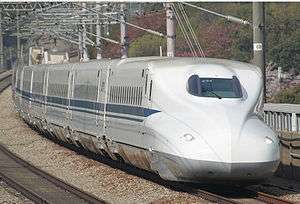 A JR central N700 series train
A JR central N700 series train
Preserved examples
- 723-9001 (ex-prototype set C1, built 1997 by Kawasaki Heavy Industries) at the SCMaglev and Railway Park, Nagoya, from 2 January 2014.[8]
See also
References
- JR全車両ハンドブック2006 [JR Rolling Stock Handbook 2006]. Japan: Neko Publishing. 2006.
- ↑ JR電車編成表 2016夏 [JR EMU Formations - Summer 2016] (in Japanese). Japan: Kotsu Shimbunsha. 20 May 2016. pp. 108, 130–132. ISBN 978-4-330-68216-7.
- ↑ N700Aの追加投入について 全ての東海道新幹線が「N700Aタイプ」になります [Details of additional N700A introductions - All Tokaido Shinkansen services to become N700A type] (pdf). News release (in Japanese). Japan: Central Japan Railway Company. 22 October 2015. Retrieved 22 October 2015.
- ↑ JR Central press release: "700系の加速度向上について" (Increased acceleration for 700 series) (26 June 2009). Retrieved on 28 June 2009. (in Japanese)
- ↑ JR電車編成表 2013夏 [JR EMU Formations - Summer 2013]. Japan: JRR. May 2013. pp. 413–415. ISBN 978-4-330-37313-3.
- 1 2 3 JR電車編成表 2011夏 [JR EMU Formations - Summer 2011]. Japan: JRR. May 2010. ISBN 978-4-330-21211-1.
- 1 2 JR特急列車年鑑2014 [Limited Express Annual 2014]. Tokyo, Japan: Ikaros Publications Ltd. 20 December 2013. pp. 140–141. ISBN 978-4-86320-793-6.
- ↑ Ikeguchi, Eiji (December 2016). 700系新幹線の軌跡 [The 700 series trajectory]. Japan Railfan Magazine (in Japanese). Vol. 56 no. 668. Japan: Koyusha Co., Ltd. p. 19.
- ↑ リニア・鉄道館 700系新幹線電車の展示について [700 series shinkansen exhibit at SCMaglev and Railway Park] (pdf). News release (in Japanese). Japan: Central Japan Railway Company. 13 November 2013. Retrieved 14 November 2013.
External links
| Wikimedia Commons has media related to 700 series Shinkansen. |
- JR Central 700 series (in Japanese)
